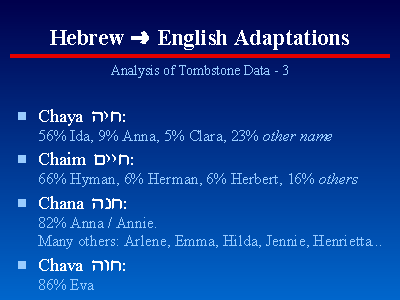 |
 |
(3) Phonetic Similarity. These are the vast majority, where the new and old names sound similar. Often no more than the first sound or letters coincide. For example, of those with the American name Bertha, 26% had the Hebrew name Breina, 26% were Beila, 17% Bracha, and 9% Bluma. Of those named Samuel, 40% were Shmuel (the language-equivalent name), but 10% were Shimon, 9% Yehoshua, 7% Simcha, 6% Sholem, 6% Shlomo, 5% Yisrael, 3% Yishaya, and smaller numbers of Shimshon, Shabtai, Shaul, Sender, Sinai, Tzadik, etc. Note that in some of the above cases, it is the Yiddish diminutive name (such as Shaya for Yishaya or Srul for Yisrael) that has the common initial sound or letter with the new American name.
Another factor was assonance, or vowel patterns. 56% of those named Chaya became Ida, 82% of Chanas became Anna or Annie, and most Sheinas became Jennie.
It is important to note that the new American name could be based upon any of the immigrant's Hebrew or Yiddish names. For example, 97% of those with the Hebrew name Ze'ev became William, because the Yiddish calque of Ze'ev is Vulf, and Wulf has a phonetic similarity to William. 70% of those named Aryeh became Louis, because the Yiddish calque of Aryeh is Leib. Those named Betzalel often became Charles, because a diminutive of Betzalel, "Tzali", has a phonetic similarity to a diminutive of Charles, "Charlie".
(4) No connection. In a small number of cases, the immigrant chose a new name that had nothing to do with their Hebrew or Yiddish names. Yitzchak Shlomo became Fred, Ryfka Leah became Augusta, etc., in isolated cases.